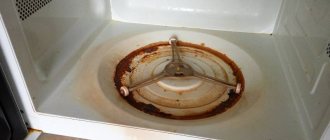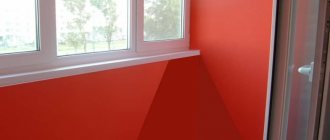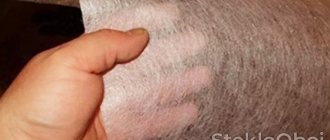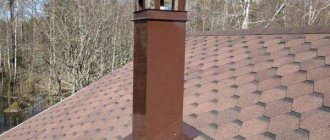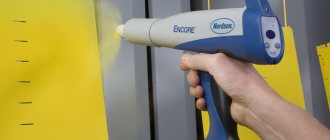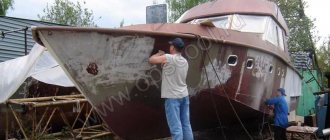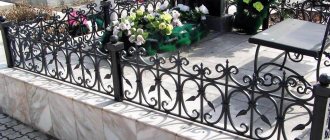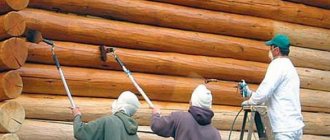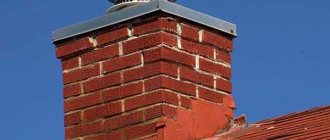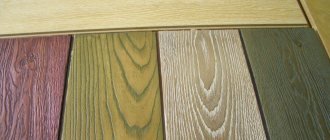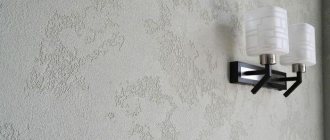What causes the need for coloring?
Experts recommend painting with special paints to ensure 2 main functions:
- protective, since the thin zinc layer gradually becomes thinner and becomes unable to withstand negative natural influences;
- A decorative, varied color palette, instead of the original gray color, will give the metal structures and the entire building an original and attractive appearance.
Based on the results of numerous experiments, it was concluded that it is best to paint galvanized iron after a year, during which time the galvanized sheets will “age” naturally, the surface will acquire a roughness that improves adhesion when applying paint. If it is necessary to carry out painting at an earlier date, the surface of the sheets is treated with abrasives.
Why paint galvanized iron
Galvanized metal does not rot or rust under the influence of the environment.
Galvanized metal does not rot or rust under the influence of the environment. Therefore, at first glance, there is no reason to paint this material. But if we consider the real situation, then everything is somewhat more complicated.
Zinc is one of the rather soft metals, so scratches may appear during transportation or installation, the depth of which reaches 0.1 mm. A galvanized roof does not withstand the abrasive effects of wind due to dust and fine sand. As a result of prolonged exposure to galvanized metal, stripes may appear on it without protection. Most often this is observed in the area of the ridge, roof overhangs or eaves.
If the roof is not painted on time, a white coating may soon begin to form and after that the corrosion process will be quite problematic to stop.
It is worth noting that after the zinc layer is erased from the metal, corrosion begins to penetrate under the protection itself. Because of this, the damaged area may be much larger than it appears at first glance.
Why do you need to paint a galvanized roof?
Oddly enough, asking the question of how important it is to paint a galvanized roof often confuses future owners. A very popular myth among car lovers and handicraftsmen is that galvanized metal, even under extreme conditions of city streets, does not begin to rot and rust. For this reason, we can say formally, there is no reason to paint galvanized roofing.
In reality, the situation with galvanized roofing is much more confusing and complex:
Zinc is a metal that is relatively soft, which is why, during transportation and installation, scratches with a depth of up to 0.01 cm are formed on the galvanized surface.- The galvanized roof surface will be less resistant to the abrasive effects of wind with raised dust and fine sand.
As a result, due to the friction of sand, bald stripes are formed on the shiny surface of the metal, and even more so in the area of the ridge, roof overhangs and eaves without galvanized protection. If you do not paint the roof in time, a whitish coating will quickly form, and further stopping the corrosion process will be very difficult.
Please note that after the galvanized layer is erased with an abrasive, rust will begin to get under the protective layer, and therefore the dimensions of the affected surface can be much larger than the visible type of stain.
The shiny initial galvanization of a standing seam roof gives the overall structure a festive look, although most owners prefer more natural or natural colors instead of galvanized, for example, the paints of fired tiles or the colored colors of a bitumen roof. This is an additional method of painting a galvanized steel roof, especially since the sooner you start painting, the more durable the decorative layer will be.
What requirements must paint compositions meet?
When selecting paints, it is necessary to take into account the presence of the following mandatory properties:
- providing long-lasting protection from negative atmospheric factors;
- galvanized paint should not fade under sunlight;
- possessing high elasticity and adhesion;
- good hydrophobicity, providing resistance to moisture in the form of rain and snow;
- sufficient frost resistance and resistance to temperature changes when used for outdoor work;
- quick drying;
- ease of application;
- harmless to human health and the environment;
- attractive appearance.
Types of paints
Painting galvanized steel, which has a high degree of passivity, is recommended to significantly increase the service life. When choosing how to paint galvanized steel so that the paint does not peel off, the mandatory presence of elastic characteristics and good adhesion quality are taken into account.
Not all paints and varnishes will be able to cope with the task. For this purpose, alkyd, acrylic, rubber, and vinyl enamels can be considered.
Painting galvanized steel, which has a high degree of passivity, is recommended to significantly increase the service life.
Acrylic
The first in the rating of products for painting galvanized steel is the acrylic type of paint. They create reliable protection and contain anti-corrosion substances as components. The following advantages are also noted:
- Resistant to temperature changes and ultraviolet radiation;
- Duration of operation;
- Moisture resistant property;
- High degree of adhesion;
- Good value for money.
Acrylic paints provide reliable protection; their components include anti-corrosion substances.
Alkyd
This type creates good protection. A glossy finish is created on the surface. They contain elements that help avoid corrosion on the material. It should be noted that the constituent components react with zinc, and as a result its structure changes in a negative direction.
Regularly chosen for painting near the ocean and sea.
This type creates good protection.
Vinyl enamels
Vinyl paints may be the best option for this material. According to a number of indicators, the vinyl type copes better than other enamels in protecting the material. They are distinguished by high rates of creating a barrier from surrounding factors.
They are distinguished by high rates of creating a barrier from surrounding factors.
Special coloring compounds
Painting galvanized sheets should optimally be done with special paints, which were developed for this purpose. You can use acrylic primers, which perform two functions - protection and creation of a beautiful coating. The cost is higher, but the resulting properties easily justify it. Some people choose paints with rubber crumbs, which also create a reliable coating for the material.
Painting galvanized sheets should optimally be done with special paints, which were developed for this purpose.
Imported paints
Among foreign products for painting galvanized steel with your own hands, buyers also highlight Tikkurila. “Hammerite” can be applied to metal that has already been corroded without prior preparation. However, over time, if there is corrosion, the layer will peel off, so it is better to clean this area in advance. The quality of foreign paints is good, but the price is higher than Russian ones.
The quality of foreign paints is good, but the price is higher than Russian ones.
Domestic products
Among Russian products, a special place is occupied by Tsikrol paint, which is distinguished by its high quality. This is a specialized product for painting galvanized steel. In addition to good performance characteristics, the possibility of painting without a priming step is noted.
Among Russian products, a special place is occupied by Tsikrol paint, which is distinguished by its high quality.
Rubber coloring compound
On sale you can find special rubber solutions that can be used to paint galvanized iron. They tolerate even prolonged exposure to moisture very well and can be used in different weather conditions. In addition, such compositions are completely safe for human health and are among environmentally friendly materials.
We recommend: Do-it-yourself toilet repair with plastic panels
PAINTING ON GALVANIZED IRON
Galvanized sheet or “galvanization” is one of the most popular coating building materials; it consists of steel sheets with a thin layer of metallic zinc applied to the surface.
Galvanization is especially often used as a roofing covering, in drainage systems, in the manufacture of chimneys, canopies and cornices. The zinc coating serves to protect the ferrous metal from adverse external influences (precipitation, industrial gases - carbon dioxide, sulfur dioxide, nitrogen oxides, car exhaust gases, ultraviolet radiation from the sun, salts and other factors). The presence of a zinc coating allows you to extend the service life of metal products that are used, as a rule, in the open air, constantly exposed to negative environmental influences and the influence of the corrosive factors listed above. But the zinc layer is also susceptible to corrosion, although to a much lesser extent than unprotected steel. Over time, “white rust” appears on the surface, i.e. Zinc oxide is a porous white coating through which moisture and air oxygen begin to easily penetrate to the steel sheet due to diffusion forces, so “galvanization” itself needs additional protection. The most effective and simple solution is to apply paint and varnish coatings to the galvanized surface. Let's consider whether it is possible to paint galvanized iron and, if so, what and how best to do it.
How to distinguish stainless steel from galvanized
Both materials are often used to construct coatings that are not susceptible to corrosion. Stainless steel has longer anti-corrosion properties, durability of up to 50 years and is more expensive, so unscrupulous sellers can slip galvanized steel to the buyer under its guise. After all, high-quality stainless steel is practically indistinguishable in appearance from galvanized steel.
The main differences visible upon external examination:
- if the sheets are thick enough, you can notice the heterogeneity of the galvanized product in the sections;
- The galvanized sheet may have individual characteristic spots, called crystallization patterns. In the absence of such spots, the surface is mirror-like with a slight bluish tint. The surface of stainless steel is more matte;
- magnets are not attracted to most stainless steels;
- zinc actively interacts with hydrochloric acid, therefore, when a drop of acid gets on the galvanized surface, swelling is observed with the gradual dissolution of zinc;
- galvanized steel is easily scratched by a nail.
The most accurate determination of the type of material can only be carried out by spectral analysis, but this requires the availability of appropriate equipment and instruments, as well as time costs.
The last method is to select suppliers from well-known companies that have been working in the sales market for a long time, and legally competent registration of the purchase with the provision of quality certificates.
- Roof
- Exterior finishing
Polyurethane paints for galvanized roofs
Coatings based on polymer urethane resins are considered more resistant to external loads. Experts recommend using polyurethane paint and varnish compositions in cases where there is a huge amount of sand, ice and other materials on the roof that have an abrasive effect on the galvanized coating.
Polyurethane and alkyl-urethane paints perfectly preserve the color scheme; it is believed that it is best to paint old and fairly worn roofs with such materials. For example, inexpensive “Unikom” adheres perfectly and is held on to a metal roof that has been worn to holes, even if areas and traces of galvanized coating remain on the surface. Whereas, before using the most popular acrylic composition “Tsikrol”, it is best to first paint the roof with a primer that improves adhesion to zinc.
Review of materials
Acrylic paints
The most popular materials for galvanized roofs are those based on water and alkyds. Polymers and acrylates based on them have the least degree of corrosion activity towards zinc, and therefore paints of this class can be used to paint standing seam roofs in bright colors. But the adhesion strength of acrylic coatings to galvanized metal is low, since they can be used for small parts, for example, additional elements. For example, paint and varnish material with the brand “Tsirkol” and its analogues can be applied using a spray gun, a brush or a simple paint roller. For full-size roof slopes that are covered with iron, it is better to use composite mixtures of acrylic-type resins and cyclohesanone-formaldehyde, which are dissolved in a polar solvent, usually based on butyl and ethyl alcohol. Zinc and aluminum powder are used as coloring pigments.
Please note that if the metal from which the filler toner is created is placed to the left of the zinc in the range of electrical voltages or potentials of the metal, then a galvanic couple will not form.
In this sense, aluminum is the best material, because due to the oxide film it will not exhibit activity when in contact with solvents. A good choice of paint and varnish material for new galvanized roofs is Serebrol, which has a semi-matte sheen. To achieve high quality coating, painting a galvanized roof with two layers of enamel is enough. The Belarusian paint MAV BASTION KR-12 has an excellent reputation.
Polyurethane coatings for galvanized roofs
Coatings based on polymer urethane resins can be considered more resistant to external loads. Experts advise using polyurethane paint and varnish compositions in cases where there is a large amount of ice, sand and other materials on the roof that have an abrasive effect on the galvanized coating. How to paint a rusty galvanized roof of a house? Alkyl-urethane and polyurethane paints and varnishes retain color well, and are considered to be the best materials to use for painting worn out old roofs. For example, inexpensive UNIKOM paint fits perfectly on the roof and stays on a metal roof worn to holes, even if traces of galvanized coating remain on the surface. And before using the most popular Tsikrol paint, it is better to pre-paint the roof with a primer that improves adhesion to zinc.
Alkyd and composite coatings
If the roof of a galvanized type house is exposed to strong gusts of wind, or there are other unfavorable conditions that negatively affect the condition of the roof, then it is best to use more modern versions of paint-and-varnish coatings based on urethane and epoxy resins to protect galvanized metal. For example, you can use the same “Serebrol” based on epoxy and perchlorovinyl resins. This product is perfect not only for standing seam roofing, but the material is ideal for painting galvanized drainpipes and gutters. This way you can reduce the wear of the drainage part by almost 3 times. alkyd enamels are used for painting roofs in limited quantities. And although a roof painted with an alkyd-urethane composition looks quite beautiful, the paint coating does not adhere so firmly to a galvanized surface. For this reason, to paint zinc, you need to buy an additional primer or use more expensive 3-in-1 compositions, with an adhesive primer, a corrosion inhibitor and a shine former.
Helpful advice! If you have a choice, it is best to paint galvanized surfaces with paints and varnishes in light colors, without pigments based on iron and copper oxides. This not only improves the protection of the coating, but also hides light spots of zinc that have oxidized.
Paint requirements
When choosing paint for painting galvanized iron, it is necessary that the composition has certain properties.
- Protected for a long time from exposure to moisture and precipitation.
- The paint should not lose its color when exposed to sunlight.
- The material must have a high rate of adhesion and elasticity.
- The composition must have excellent hydrophobicity, so galvanized iron can withstand exposure to precipitation well.
- Can be used for outdoor work, because it tolerates temperature changes well.
- Has an attractive appearance.
Requirements for coloring compositions
Not every paint is suitable for a smooth finish. It must have maximum adhesion, that is, ideally adhere to the surface. Since galvanizing, although to a lesser extent, is also susceptible to corrosion (as evidenced by the appearance of whitish spots on it), it is desirable that the paint contains anti-corrosion components.
Traditional alkyd compositions based on resins that can react with zinc, as well as oil paints, are not suitable for these purposes. They contain not only acids and alkalis, but also some additives that can destroy the galvanized surface. Therefore, paint and varnish materials used for painting must be neutral to zinc.
Paint on galvanized metal intended for exterior use must be frost- and chemical-resistant and resistant to UV rays. Particular attention must be paid to its elasticity - after all, zinc changes dimensions when the temperature changes. Regular paint will crack and peel during use. Naturally, the color should also be selected so that it matches the exterior of the other buildings.
Painting galvanized corrugated sheets: choice of paint, application methods
Galvanized corrugated sheeting is susceptible to the negative influence of weather conditions. Intense precipitation and temperature changes lead to corrosive processes on the surface of the sheet, which reduces the protective properties and reduces the strength of the material.
To avoid such problems, special paint is applied to galvanized corrugated sheets. It can give the sheet surface an aesthetic appearance, and also has a number of individual advantages.
Modern corrugated sheets are initially coated with a polymer layer and do not require additional painting. It protects against corrosion and increases service life to an average of 45 years.
The need to paint galvanized corrugated sheeting may arise in case of damage during transportation or installation. Cheap profiled sheets also require additional coating to increase their protective properties.
Often, fences or old galvanized roofing are repainted to restore faded areas and extend their service life.
Useful properties from applying paint and varnish coating:
- increase in service life (by 10-15 years),
- getting rid of cracks, scratches and chips,
- protection from precipitation and exposure to ultraviolet radiation,
- increased resistance to mechanical and atmospheric influences,
- preservation of material properties at different temperatures (painted corrugated sheeting can withstand changes from -55°C to +140°C).
Choosing the right paint
Acrylic paints
Matte acrylic paints contain active anti-corrosion additives with organic solvents. They are excellent for exterior finishing of galvanized surfaces. Acrylic options have increased light resistance. Such paints can withstand atmospheric influences and are not affected by moisture.
The advantage of acrylic paints is that they do not require pre-treatment of the surface of the corrugated sheet using a primer. The paint adheres securely to galvanized metal and is applied in one layer.
Alkyd enamels
An alternative option for painting galvanized corrugated sheets is alkyd enamel. The variety of colors is not inferior to coatings made of polymer materials.
Alkyd enamel can give corrugated sheets the required properties and protect them from the negative effects of the external environment. By increasing resistance to seasonal and daily temperature changes, corrugated sheets can last 10 years longer.
The main rule when using alkyd enamel is to paint when the surface of the corrugated sheet is completely dry.
Among the disadvantages of alkyd enamels, it is worth noting the fact that over time the material loses its elastic properties and becomes covered with a network of microcracks. This leads to a decrease in anti-corrosion properties. In addition, enamel on “ferrous” metals can only be applied to a pre-treated surface.
Preparing the surface for painting
Before you start painting, you should clean the surface of dirt and rust, first degrease and dry it, and then phosphate or prime the corrugated sheet.
Particularly rusty or load-bearing structures should be phosphated. Phosphosoil phosphating compound is suitable for galvanized corrugated sheets. It is first applied to the surface of the sheet, followed by drying for 3-12 hours, depending on the air temperature.
Only after completing all the preparatory procedures can you begin to directly apply paint to the surface.
A regular alkaline solution based on washing powder is suitable for degreasing the surface. After washing, the remaining detergent is washed off with clean water under low pressure, and the sheet is left to dry completely.
If there is rust on the surface of the corrugated sheet, then you should definitely get rid of it using fine-grained sandpaper. This will increase adhesion and increase the adhesion of the paint to the surface. Additionally, you can prime the surface or immediately coat it with enamel (if priming is not required).
When using acrylic paints, you may not get rid of rust deposits in cracks. It can be applied directly to the surface of the corrugated sheet. Special components in the composition transform rust and prevent its appearance in the future.
Deciding on the dye
How to paint galvanized steel must be decided at the beginning of the work or even at the planning stage, since not every coloring composition may be suitable for the surface. Standard painting of galvanized elements is quite primitive, and therefore, in order for galvanized products to be combined with the overall interior of the building, they are additionally painted in the desired color.
The main purpose of zinc coating is to decorate and protect steel surfaces, elements and structures from negative external factors.
Nuances when working with galvanized surfaces
When planning to work with elements made of galvanized steel, the following points should be considered:
- You should choose a material that contains not only special additives to increase grip on the steel surface, but also anti-corrosion elements
- Galvanized products cannot be treated with paint and varnish compositions that contain chemicals that contribute to the destruction of zinc, for example, various anti-corrosion additives, acids, solvents and alkalis;
- For structures operated in harsh aggressive environments, it is necessary to use specialized compositions - electrically conductive and fire-resistant paints for metal products;
- Galvanized coatings have a smoother surface compared to untreated surfaces of the material, and therefore adhesion to other materials will be lower. Based on this, before painting galvanized steel, you should carefully prepare the working surface, increasing the adhesion of zinc to the new paint and varnish composition;
- It is also important to pay attention to the degree of elasticity of the material, since a coating with poor elasticity will simply crack and delaminate on a metal surface, which is characterized by slight changes in shape when heated and cooled. All this will lead to the fact that the composition will simply completely “peel off” from the steel surface over time.
We recommend: Ventilation grilles - the most important information
Important point! Paint for zinc should not negatively affect the characteristics of steel; it must have good adhesion, high elasticity and resistance to external negative factors.
Choosing a Zinc Coating
Steel surfaces can be treated with various colorants:
- Polymer paints, which can vary greatly in their characteristics. Today, ground enamels, as well as latex and polymer compositions, are distinguished. In practice, despite the high cost, ground enamels have proven themselves to be excellent;
- Alkyd compounds that perfectly protect metal surfaces. In addition, they stand out for their considerable service life and a wide range of colors;
- However, alkyd paints are not recommended for use as a protective agent for galvanized products due to the fact that the paint contains aggressive components that can affect the surfaces of steel elements!
- Oil paints. The characteristics of the coloring composition allow it to create a film on the treated coating that does not allow water to pass through. Thanks to this, the galvanized product becomes well protected from the effects of snow and rain. At the same time, such paints have good adhesion to steel. However, oil-based paints also contain substances that can react with zinc, causing its destruction. Based on this, it is not recommended to use such products for painting galvanized steel.
- When choosing a paint composition to protect steel elements, it is better to give preference to acrylic primer enamels containing neutral substances that cannot have any negative effect on steel!
The cost of paint can vary greatly. By and large, the price will depend on the manufacturer and the volume of the can. When purchasing, you should choose products from a trusted manufacturer. If you plan to do the painting work yourself, the final cost will be lower!
Painting of galvanized steel
Galvanized metal sheet is one of the most reliable and widespread materials used in modern construction. Durability, weather resistance, convenience and ease of use - these and many other positive qualities have made this material popular for use in both civil and private construction.
Galvanization is widely used in covering the roofs of industrial, factory, and office buildings, in the construction of hangars, industrial refrigerators, garages, warehouses, etc.
Metal galvanization
The presence of a thin layer of zinc applied to the surface of the steel sheet prevents corrosion of the steel under the influence of moisture and atmospheric oxygen, significantly extending the service life of the roof and other elements made from this material.
But zinc itself, although to a lesser extent than steel, is susceptible to corrosion, which results in the formation of a powdery substance known as “white rust.” For this reason, galvanized steel roofs require painting, which provides reliable protection from aggressive environmental influences.
Why paint galvanized steel?
Galvanized roofing, metal structures and galvanized steel hardware need painting for two reasons. Firstly, a thin layer of zinc unprotected by paint begins to rust as a result of aggressive environmental influences (precipitation, salts, exhaust gases, etc.). Secondly, painted galvanized metal has a decorative appearance and looks much more beautiful than unpainted metal.
Painting of galvanized steel
When working with galvanized steel sheet, you should not forget about an important point. It happens that as a result of improper storage or transportation, water accumulates on a new galvanized surface and does not evaporate. As a result, a white powdery substance (so-called “white rust”) may appear on the surface.
To protect galvanized sheets, some manufacturers use white rust inhibitors, which are an unsuitable base for painting and must be removed. White rust itself can be removed from the surface of the sheets by light sanding, but this may damage the thin zinc layer.
As a result of many years of testing, paint manufacturers have come to the conclusion that the best option before painting is one-year aging of galvanized sheets. What happens during this time? During this period, exposure to the atmosphere itself will partially prepare the surface for painting (by removing white rust and creating roughness for better adhesion).
The galvanized surface must be properly prepared: thoroughly wash off dirt, grease, and remove debris. Alkaline solutions (for example, washing powder) are used to remove salts, dirt and grease. The remaining detergent is thoroughly washed off with clean water, preferably under pressure, and dried well.
After careful preparation, the surface is primed or top coat enamel is immediately applied.
Galvanizing paint Tsikrol
Paint for galvanized metal Tsikrol
is a matte acrylic paint containing active anti-corrosion additives in organic solvents.
The paint is intended for painting galvanized surfaces, for external painting of steel, aluminum and galvanized surfaces. The paint is used to protect any metal roofs, roofing iron, gutters, protective sheets, downpipes, gutters and other galvanized metal structures.
Galvanizing paint has high hiding power and light fastness, and has excellent water resistance and weather resistance characteristics. Galvanizing paint is easy to use and has excellent adhesion to the surface being painted.
Cyclol
- the best option for repair painting of a galvanized surface. A significant advantage of the paint is that it does not require prior priming of the surface and is applied in one layer.
Galvanizing paint Tsikrol provides long-term protection of the surface from weathering, humidity, sun, rain, salty air, etc. Roofing paint does not fade, dries quickly, significantly extends the service life of galvanized roofs and gives them an attractive appearance.
Galvanizing paint Tsikrol 2sh
Paint for galvanized metal surfaces Tsikrol 2sh is a semi-gloss elastic polyurethane paint with increased adhesion to galvanization. Contains substances that slow down corrosion.
Zincroll 2sh is used to protect galvanized roofs, the surface of gutters, awnings and other similar surfaces. The paint has excellent decorative properties and high mechanical strength. Perfectly protects the surface from the effects of chemical compounds and aggressive atmospheric influences, even in marine or tropical climates.
The paint can be applied both to a cleaned surface and to a surface with traces of corrosion damage. Zincroll 2sh allows you to protect galvanized surfaces from destruction in temperate and cold climates for 12 years , and in tropical and marine climates for up to 7 years !
You can find out more detailed information about painting galvanized roofing (galvanized roofing, painting galvanized sheets, how to paint galvanized sheets) on the website pages.
Painting technology
In order for painting metal with your own hands to bring the desired result, you should carefully study the instructions on the container with paintwork materials and strictly adhere to them, then the treated surface will be able to maintain a good appearance for a long time.
Tools and equipment
For the classic method of painting metal, you need to prepare:
- roller, brushes of different widths;
- paint container;
- the coloring composition must be shaded;
- primer for metal.
Additionally, you will need masking tape and plastic film.
Application methods
To apply paint you can use:
- Paint brush. Suitable for painting small parts. You can find brushes of different sizes on sale. The bristles can be natural or synthetic. For access to hard-to-reach places, the tool is equipped with an elongated curved handle.
- Roller. Suitable for painting large flat surfaces.
- Sprayers. The second name for the spray gun. A compressor is used to operate them. The coloring composition is supplied under pressure. The equipment is used by large enterprises, car repair shops, carpentry, and blacksmith shops.
- Containers for dipping metal workpieces. This method makes it easy to paint parts with complex shapes.
Modern technology - powder coating of metal. The blanks are placed in a closed spray booth and covered with a layer of paint. Its particles receive a negative electrical charge and are attracted to the working surface, creating a dense, uniform layer. After applying the powder, the workpiece is placed in an oven so that the decorative layer bakes and becomes monolithic.
Preparing for painting
Before you begin painting galvanized metal, the surface to be treated should be well prepared. And, in particular, carry out work that increases the adhesion of the zinc coating.
In order for the paint composition to lie evenly and tightly on the galvanized surface, it must be absorbed and penetrate its natural microdeformations. If there are few of them, or they are practically absent, they should be created artificially. Often, for this purpose, the surface to be treated is coated with an abrasive substance.
There is another good way - if the galvanized surface (in particular, the roof) has been in contact with air for a long time - half the job is already done, since in one year fresh zinc, or rather its surface, has time to react with oxygen, while coated with a layer of oxide, which absorbs paint remarkably well. But nevertheless, even such zinc should be slightly cleaned and degreased with a solvent.
When choosing any materials for painting a roof or other galvanized surfaces, it is best to pay attention to abrasives, primers, paints and solvents from the same company, since the chemical components in them are specially selected for joint use.
Creating a protective layer on the surface
If the zinc surface has previously been coated with a layer of paint, it should be cleaned of any remnants of these materials. To do this, it is best to use a solvent and a metal brush. This work should be carried out carefully, since it is not at all advisable to remove the zinc layer along with the paint layer from the roof.
After this, again, you need to clean the surface of any remaining dirt that has formed. You can use an alkaline detergent for this.
Painting galvanized metal
Immediately before application, the coloring matter should be thoroughly mixed and poured into a special tray. It is best to apply a thin layer of paint with a roller, brush or spray. Before applying a new layer, you should wait until the previous one has dried.
It is optimal to paint in two layers. But to achieve maximum results, when the paint color will sparkle with more saturated shades, and the coating itself will have strong protective properties, you can apply three layers of paint and varnish material.
Painting Galvanized Metal: A Complete Guide
Metal has many qualities that have helped it become one of the most important materials in construction and industry. However, with all this, it also has disadvantages, and one of them is susceptibility to corrosion. To combat this phenomenon, the metal is often galvanized. At the same time, having acquired the ability to resist water, does the metal lose the ability to be painted? Let's figure it out together.
Is galvanizing effective?
The layer of zinc that covers the metal is truly capable of providing protection against corrosion. However, this does not happen forever, and over time the zinc layer becomes thinner and moisture can penetrate through it. In addition, the process of oxidation of zinc is often recorded, which also does not benefit anti-corrosion protection. Painting can become a reliable protection for the galvanization itself, not to mention the visual benefits.
When should you think about painting galvanized metal?
- A white coating begins to appear on the surface of the zinc layer. This call is extremely serious, as it indicates the destruction of galvanization. If nothing is done for a certain time, the metal will become corroded,
- Yellowing. The very beginning of rust. The process suggests that zinc can no longer cope with its mission and the metal has begun to deteriorate.
In addition, galvanized metal is also not very convenient, as it reflects the sun's rays and blinds a person. And since the layer of this coating is short-lived, it is better to prevent the process than to correct it. Therefore, many people, as soon as they receive new galvanized metal elements, immediately try to paint them.
Important! Sometimes painting of galvanized steel is done a year after the start of use. During this time, being in the open air, the metal surface is exposed to natural factors, which lead to the appearance of roughness that improves adhesion. In other words, paint adheres better to such a surface. The adhesion and strengthening of the paint layer is also improved by using a primer.
What paint to use on galvanized sheets?
So, we definitely decided that we would paint our galvanized steel at home. Now the most important thing is to decide on the type of paint and varnish material. There are several options:
Cold galvanizing technique. The optimal option is to coat it with paint containing 89-93 percent zinc. Thus, we not only give the surface the color we need, but also restore the zinc coating that has begun to deteriorate. In addition to paint, there is also a powder component, which, when heated, forms a durable protective layer. This method has several advantages:
- You can coat with this paint both previously non-galvanized metals and those that have already been subjected to this procedure,
- Despite the special properties of the paint, the process of applying it is the most common, using a brush and roller. It is possible to use a sprayer, which significantly saves time and paintwork.
Elastic paint with good adhesion . As a rule, waterproof aluminum paints, plastisol and polyester options are used. But ordinary oil or alkyd paints are not used, since they are not only unable to protect the metal from moisture, but also have a destructive effect on the galvanized layer itself. All the materials listed in this paragraph can be used, but preference is still given to zinc-containing finishing components, since their protection is much better.
The procedure for painting a roof or other galvanized surface
This process does not require any special skills, and anyone can give the desired color to a galvanized sheet. You just need to follow simple rules:
- Since the roof is a fairly dirty place, you cannot apply paint to it without thoroughly cleaning it. Moreover, if there is already paint there, then it must also be removed, being careful not to harm the galvanization. Dirt is removed with a detergent,
- Once the sheet is completely dry, you can apply paint to it. After the first layer has dried, two more are applied to consolidate the result.
PREPARING THE SURFACE FOR PAINTING
In the question “how to paint galvanized steel so that the paint does not peel off,” you should adhere to certain recommendations for preparing the surface of galvanized steel:
Removing old paint using the stripping method
For these purposes, sandpaper or sandblasting is used. Cleaning is done so that the old coating is removed, but the base is not damaged.
Treatment with a degreasing compound
Degreasers allow you to remove dirt, grease, mold and other deposits from the surface that can impair the quality of the paint. At the same time, the degreasing composition does not damage the surface of the product itself. It is recommended to carry out treatment in small areas to prevent problem areas from being missed.
We recommend: Larch furniture, pros and cons, rules for selection and placement
For cleaning and degreasing, the following are most often used:
- White Spirit;
- Chlorine bleaches;
- Comet;
- Kerosene.
Drying
It is carried out until the surface is completely dry to prevent the degreaser from reacting with further applied products.
Removing white rust
White rust occurs as a result of the destruction of the galvanized layer under the influence of the environment and is a white powdery film. White rust can be removed using fine-grit sandpaper with a grit rating of 120 or less. Sanding is done with light circular movements. At the end of the process, the dust is removed with a slightly damp cloth or rags.
Abrasive treatment
To improve the adhesive properties, allowing the paint to adhere as firmly as possible to the surface being painted, the steel must be treated with abrasives and white (distilled) vinegar. The acid contained in vinegar will etch the galvanizing and give it a rougher structure; substances containing abrasive particles will help enhance the effect.
Exposure to vinegar is usually a minimum of 1-2 hours. It is worth considering that the longer the acid acts on the surface, the more pronounced the etching effect.
Padding
Most often, latex and epoxy primers for exterior use are used for these purposes. It is worth considering that due to its durability and resistance to damage, epoxy primer is optimal in cases where the product will be in the most aggressive conditions. The composition is applied with a brush or spray. The latter is most appropriate if we are talking about a large cultivated area. Application is carried out in a sectional manner, allowing for the most accurate distribution of the primer. Exposure time depends on the brand of primer mixture used and averages from 2 to 6 hours. You can start painting only after the primer has completely dried and there is no sticky effect.
Painting the roof: rules for selecting and applying paint from various components
Steel roofs made of galvanized and non-galvanized sheets are not uncommon in suburban construction. They have one drawback - they need to be painted. In this article we will look at what paint and varnish materials are used to paint the roof of a house, and what technologies are used for this. The information received will help you understand all the intricacies of the process.
Painting the roof of a house
Paint selection
Metal roofing paint must have some important properties:
- do not interact with metal
in terms of corrosion formation; - have a plastic structure
that would ensure uniform stretching of the applied layer during the thermal expansion of metal sheets under the influence of sunlight and positive air temperatures; - do not crack
at sub-zero temperatures and under the influence of ultraviolet radiation; - have good adhesive properties
.
Therefore, any water-based paints and varnishes for painting roofs
are not used. Alkyd and oil paints should not be used. The reason is low elasticity after drying.
And although these two varieties were previously used to cover metal roofing material, the roofs had to be repainted with enviable consistency, which affected the cost of maintaining roofing structures.
Today, roof paints are special materials that contain anti-corrosion inhibitors. These include acrylic varieties that have all the positive characteristics outlined above.
Metal paints
The only negative is the high price, which is justified by the long service life of iron roofing material. Today, manufacturers offer water-based acrylic paints, but they contain anti-corrosion active additives, which reduces the risk of rust formation.
Rubber paint
This new variety has nothing to do with rubber. It got its name only because it has high elasticity. In appearance it resembles polymer mastic for self-leveling floors, but its composition is different:
- latex
gives plasticity, - The coalescent
forms a durable film on the surface, - antifreeze
is responsible for frost resistance, - water
is a binding element, - preservative
– protection against mold and fungi, - pigments and fungicides
.
Rubber paint for metal roofs requires careful preparation of the surface to be painted. If this is not done, then there is a high probability that the applied layer, when the metal expands, will simply peel off in sections precisely in those places where the preparation was carried out unsatisfactorily.
Rubber paint On our website you can find contacts of construction companies that offer exterior finishing services, reconstruction and turnkey rebuilding of houses. You can communicate directly with representatives by visiting the “Low-Rise Country” exhibition of houses.
Paints for rust
This type of paint and varnish material belongs to the category of “anti-corrosion”.
And although advertising brochures claim that a rust-covered roof can be painted without pre-treatment, experts recommend partial removal of rust.
Therefore, advice number two - if sections of the metal roof are heavily rusted, then there is no point in painting them; it is better to carry out repairs and completely replace the section with new sheets of iron.
Anti-rust metal roof paint contains special chemical additives. With their help, corrosion stains are stopped. That is, rust does not spread to “healthy” areas.
We recommend: Paint for paving slabs - characteristics and application
Enamel for rust
For galvanizing
five types of paint for galvanized roofs
, which are also used for painting copper roofs:
- acrylic;
- epoxy;
- rubber;
- vinyl;
- alkyd.
Each type has its pros and cons. Of all the proposed paints, the most unpretentious is “Tikkurila” based on epoxy resin. The only requirement for this paint is to apply it at positive temperatures not lower than +15C, when the temperature of the metal allows for good bonding with the applied paint layer.
Acrylic variety for galvanizing This might be interesting!
In the article at the following link, read about painting a wooden house.
The application technology of all types does not differ much from each other. Much will depend on what type of roof is being painted: a newly built one or an old one with corroded areas.
Painting a new roof
First of all, the roofing metal material is cleaned. Remove debris and wash the surface with water. The paint is applied only to a dry roof, so it must dry after washing.
- If a roof lined with sheets of black iron
, then it is pre-treated with special primers, which additionally protect the metal from the negative effects of moisture. The primer is applied in two layers, each of which must dry well. Depending on the air temperature, this takes from 2 to 6 hours. Therefore, this stage may drag on for a day. - Galvanized sheets
can be painted without additional treatment.
Primer of roofing material
Painting an old roof
The main task of the work manufacturer is to thoroughly prepare the roof surfaces for painting.
- The roof is inspected
to identify rusty areas. - Determine the degree of corrosion
. If the degree is severe, then repair work is carried out. - Rusty areas are cleaned with an iron brush
manually or using a grinder. - The roof is cleared
of debris and dirt. - If necessary, wash with water
and dry well. - Regardless of what metal the roof was assembled from, corrosive areas are treated with primers
. Often the entire roof plane is treated. The number of layers is two, each should dry well. - A day later the paint coating
. Ideally, two layers.
Painting a metal roof goes through several stages - from cleaning off corrosion to applying a protective layer. This can be interesting!
In the article at the following link, read about how to paint a wooden floor in a house.
How to apply paint
In principle, paint is applied to roofing material using the same tools as on any other surface. These are brushes, a paint roller and a spray bottle. It should be noted that painting with a brush takes a long time, and the material consumption is increased. The roller is the golden mean: the speed is higher, the layer is applied thinner. A spray bottle is the ideal option: the highest application speed, plus minimal consumption.
But it should be noted that, for example, rubber paint in its pure form cannot be applied with a spray gun. Alternatively, it can be diluted, for which it is better to use a thinner recommended by the manufacturer of paint and varnish products. In addition, the size of the applied layer has its own requirements.
Spray painting the roof
Slate painting
A slate roof is painted for only one reason - to give it a more presentable appearance. For this it is better to use silicone or acrylic paints and enamels. And here it doesn’t matter whether they are water-based or diluted with organic solvents. But it should be noted that the second option has higher positive characteristics:
- the film
formed on the surface is more durable; - high water-repellent
qualities; - increased elasticity
; - resistance to ultraviolet radiation
; - color
longer .
The only negative is the pungent odor, which disappears after the applied layer dries. Although for outdoor work this factor is not decisive.
The material is first treated with a primer, which closes the pores on the surface. It is better to paint with a brush with stiff bristles. In this case, the roller is completely inappropriate; it cannot paint the lower waves (at least it’s difficult). It is easier to paint slate that is lying on the ground and has not yet been installed. It’s more difficult with one that is already attached to the rafter system.
Painting slate should be done carefully - slate is a fragile material
Recommendations from experts
Roofing paint can be
applied at an optimal temperature
equal to the range of +10-25C.- It is not recommended to apply paint in direct sunlight
. - Painting should not be carried out in the rain
. Do not apply paint and varnish material to a wet surface. - If you need to use a solvent
, then you need to choose the one specified by the manufacturer in the instructions. - The applied layer must dry within the time
specified by the manufacturer. Only after this is the second coating applied. - The paint should be applied evenly in a thin layer
. Leaks must be avoided.
Painting a roof is not the easiest process, as the video proves:
This might be interesting!
In the article at the following link, read about paint for the foundation plinth.
Generalization on the topic
The main task of the manufacturer of roof painting works (metal and asbestos-cement) is to accurately select the paint and apply it correctly, taking into account the manufacturer’s recommendations and requirements. Despite the apparent simplicity, such work has many pitfalls, so it is recommended to turn to professionals.
We recommend: Choosing a varnish to cover a pine wooden floor
Advantages and disadvantages of the method
The pros and cons of painting metal depend on the type of paint composition used. Advantages of painting metal surfaces, provided the technology is followed:
- Getting the required shade. You can find different colors on sale.
- Availability of consumables.
- Easy to apply paint using a brush or roller.
- Protection against rust formation.
Flaws:
- Many types of coloring compounds emit a persistent, unpleasant odor. The room needs to be ventilated for a long time.
- For powder coating you will need special equipment, a spray booth.
- Not all types of paint protect metal from corrosion.
Most of the shortcomings can be leveled out if you buy a high-quality coloring composition and carry out the work strictly following the technology.
How to paint galvanized metal
For a quality result, it is important not only to choose the right paint, but also to know how to paint. First of all, the preparatory work is carried out:
• remove old paint; • remove dirt; • the surface is washed; • degrease; • dried; • repair defects.
Then you need to paint the galvanized metal. Paint on galvanized iron is applied with brushes, rollers or spray guns. Acrylic primer enamels can be applied in 2-3 layers. Efficiency can be increased by using several primer compositions.
First, before painting, apply the first composition, then after complete drying the second. The primer is applied with a lint roller. Then a primer with anti-corrosion characteristics is applied. After this, you can apply primer-enamel.
Tips for painting metal and choosing paint (2 videos)
Products of different brands (35 photos)
How not to paint galvanized steel
Protective coated roofing material should not be painted with paint compounds containing high acid salts or alkaline soaps, commonly used in paints to promote adhesion and convert rust to iron phosphate. Unlike steel, the zinc layer quickly dissolves with the formation of amphoteric compounds, as a result of which the paint peels off and comes off the roof surface along with the galvanized coating.
The second limitation is the presence in the paint of special toners or pigments based on powdered copper, tin or antimony. If you paint galvanized paint with copper pimento paint, even in oxidized form, the process of degradation of the roofing coating still occurs, although at a noticeably lower rate than with direct contact with copper.
Protective equipment and precautions
We should not forget that toxic and flammable substances are used in the work, for this reason it is necessary to prevent any possibility of contact of paint with open fire. Smoking is strictly prohibited in the area. If work is carried out indoors, care must be taken to ensure that it is properly ventilated during and after work.
If you have a large volume of such work on a large area of the surface to be painted, get respirators to protect your respiratory tract. Do not forget to use special clothing, gloves and comfortable shoes.
- How to use
- Construction paints
- Working with paints
Features of painting a galvanized roof
There are several ways to paint a galvanized iron roof; the tools and painting techniques are practically no different from those used to apply paint to a regular metal surface, for example, when painting a metal gate or a black steel fence.
But zinc is an unusual metal; its structure is such that, regardless of the method of application to thin sheet steel, the galvanized surface is formed from a huge number of microcrystals. If you touch the galvanized surface with your fingers, the thin zinc film will seem slightly greasy, as if a small amount of silicone grease had been applied to it.
Sometimes would-be craftsmen, before painting a galvanized roof, treat the metal with a solvent, just as is done when applying paint to ordinary black steel. As a result, the paint lies unevenly on the roof surface, often even rolling off in microdrops.
Therefore, before painting galvanized iron on a roof, you will need, at a minimum, to properly prepare the surface and carry out a treatment that increases the adhesion and stability of the paint base.
How to paint a galvanized roof of a house
The method of applying a protective layer to galvanizing depends on the size of the roof and the characteristics of the material. First of all, it is necessary to prepare the surface of the galvanized roof.
The stripping scheme looks like this:
- The old layer of paint is removed. If the new and old coatings are of the same type, made on the same polymer base, then you only need to remove the outer oxidized layer of paint;
- Apply primer, it is best to use Rostex Super or its analogues; the primer base was specially developed as an adhesive for acrylic and composite coatings;
- Dry the primer layer thoroughly and paint.
For your information! Many paints and varnishes can be applied to primer or directly galvanized, even at subzero temperatures. If it is not possible to paint during the warm part of the day, then it is better to postpone the work until there is a steady frost.
It is best not to paint in the range from 0°C to +8°C due to the formation of a layer of condensation on the roof.
Tips and tricks
Maximum surface quality can only be achieved in calm weather, so the best time to paint the roof is a quiet autumn morning. Cleaning and preparing the roof surface can be done the evening before the work.
The second layer is applied to the metal in the evening, after thoroughly drying the surface. During this time, it is important to inspect the applied first layer and identify flaws and places that require touch-up.
The last pass is to tint the details of the drainage system and the ridge.

